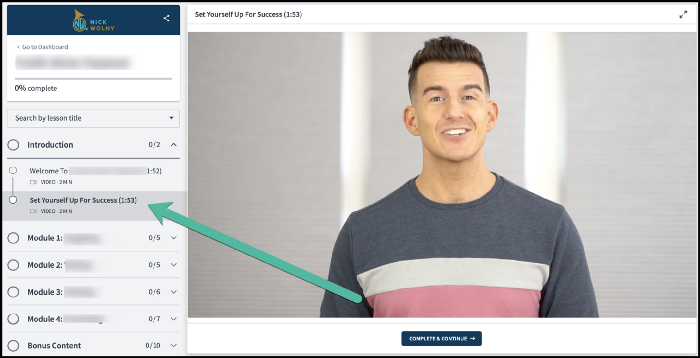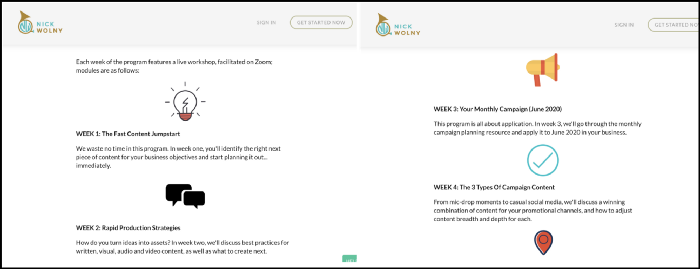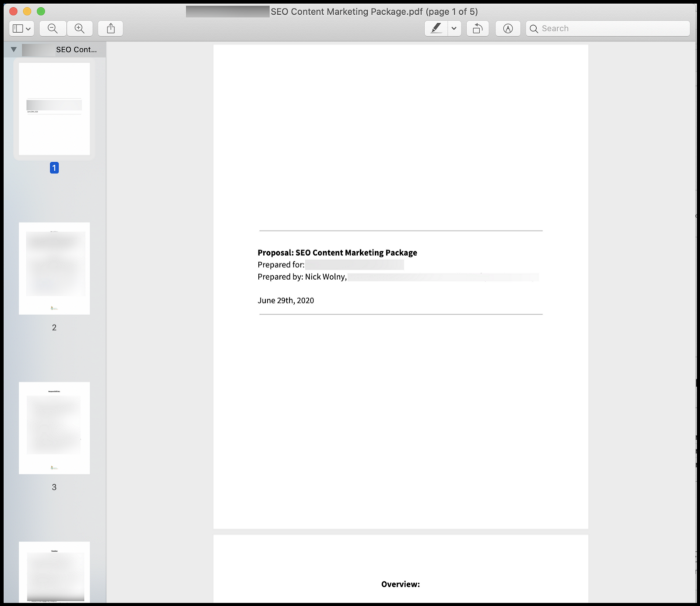Do you want your writing online to make money? Are you excited about the idea of using the internet and the written word to reach more people and attract happy customers? Before you smack me with a hard sell on your newest product, program, or service, you first need to tell us what it is and adjust your copywriting accordingly. Here’s the good news: Online products, programs, and services are really hot at the moment, and if you’re eyeing a new offer of some kind that can be sold virtually, the time to strike is now.
It can be a challenge to write or speak about our own work through an objective lens. Prior to working for myself, I was at a startup PR agency that mainly worked with authors, coaches, and entrepreneurs. These subject matter experts were highly knowledgeable in their fields, and some were highly credentialed. But when it came to talking about who they are and what they do -- a basic element for any good PR or visibility campaign -- they often struggled at it.
"My flagship program helps lost souls find their sparkle again!" … okay, that's great. But what is it, exactly? Are you a psychic? Are you an astronaut? Am I doing self-guided video lessons, or are we meditating together in silence over Zoom? Or am I just handing you the keys and letting you solve my problems? Give me some basic details about who you are and what you do.
Should You Sell Products, Programs, Or Services? – Post Outline
What helped experts get clear and then get booked at my old agency was to look at their offers and business model, see whether the majority of their revenue came from products, programs, or services, and then reverse-engineer their message based on how the money moved. This approach adds a little extra oomph to your messaging because consumers buy products, programs, and services for different reasons, so the way you write about each of them needs to be distinct and nuanced.
In this article, I’ll go through the three main buckets of selling your expertise online. They are:
- Products: D.I.Y. (Do It Yourself) offers,
- Programs: D.W.Y. (Done-With-You) offers, and
- Services: D.F.Y. (Done-For-You) offers.
We’ll cover each offer format at a high level, go over some details to take into consideration, and -- most importantly -- discern how to write about them in a way that triggers interest and excitement. Let’s dive in.
#1: Information Products, aka D.I.Y. (“Do It Yourself”) Offers
For ages now, I’ve been *such* a sucker for online courses. Maybe it’s because I loved school and loved learning and have a competitive personality. Maybe it’s because in my twenties I got really into yoga and self development space, which lean heavily on the idea of personal growth. If you sold your expertise online in a course or ebook format between 2013 and 2016, I probably bought it.
I’ve said a hundred times now that the biggest value proposition of an information product is that you’re going to give your customer the right steps in the right order. People will pay for this! An information product consumer is also usually high on time and low on cash; the idea that they can get access to your winning formula and learn it themselves for a fraction of the cost of working with you is attractive. The most obvious and successful information product in history is, of course, a book.
Can you teach programmers how to sharpen up their LinkedIn profiles? Can you teach personal trainers how to direct message corporate HR professionals to pitch virtual training sessions for staff? If you can help a specific group of people achieve a specific and desirable result, you can create an information product. Information products could include:
- Course content - Again, the #1 value proposition of an information product is to deliver the right information in the right order. What types of blog posts or videos help your customer take the right next step? Create that content and you have an information product. Remember: you are selling a framework.
- Swipe file content - A swipe file refers to anything that your customer can copy or download and start using immediately. Swipe files save time and mental energy -- I love ‘em! Think about how templates, spreadsheets, calculators, lists, or other prompts could make your customer more successful.
- A paid newsletter - I’ve never sold this, but see loads of writers who do. It’s actually a blessing that there’s so much content on the internet these days, because people are so overwhelmed they’ll actually pay to receive relevant content. If you love writing, take the advice you’d tell someone who takes you out for a coffee to pick your brain and put it into a newsletter instead. Substack is a lean paid newsletter solution.
Communicating the right steps in the right order is critical. In one of my information products, a video mini-course, I use an entire video in the introduction to go over the framework again so my students don’t get lost in the middle. Since this is a hands-off offering, I‘m not available to step in and help out, so I need my messaging to lay out the road to success in a clear, clean way.

How to write about information products
You want to motivate readers to not only buy your product, but also actually consume it. Have your writing lean in to the benefits and outcomes of your product. The bigger the transformation your product delivers, the higher the price point you can command.
I once bought an $11 course on how to use Photoshop that was over 50 hours of video content. Tons of video and effort, but not super transformational in my life. Also, I never finished it or even came close, and giant courses like that give me pause these days.
In contrast, an information product like Ramit Sethi’s Find Your Dream Job video course cost me $2,000 USD and consisted of 8 slideshow video presentations at the time of purchase. But by following this framework, I landed new employment opportunities, which made it very transformational and worth every penny.
#2: Programs, aka D.W.Y. (Done-With-You) Offers
I have a soft spot for programs, because again I loved school and saw each semester as a new challenge that had a finite beginning and end. When you sell a program, you can help your clients in real time at a fraction of what it would cost to work with you one-on-one. Programs can also scale very nicely if you want them to; sometimes the same format can serve 5, 15, or 50 people. Think about how a schoolteacher prepares lessons and experiences for their class, and apply the same logic to your own programs.
Programs are a sweet spot in online business that just don’t get enough hype. You either hear about entrepreneurs making a mountain of cash with a stream of completely passive income, or you hear about people landing huge ghostwriting gigs or dream copywriting offers. In my experience, live programs are not only lucrative, they can also be really fun. And when you set them up correctly, you’re able to create them in real time, which is advantageous. You’re not leveraging your time in the same way that you normally would. Programs might consist of:
- Group programs - Want to cultivate a group of people working together? In a group experience, the needs of different individuals help to co-create the curriculum, which gives the program a more custom experience. Participants can also observe the coaching or work that’s being done with others, which expands their knowledge and also helps them feel more related to their peers.
- A community - Did I mention people just want to be related to their peers? There is so much content everywhere nowadays that a new fad is emerging: groups and communities that you pay to be in, but have no content to them at all. I’d buy it. It’s hard to find “your people” on the internet these days, especially people who could become your clients or part of your trusted network, so I’ll gladly pay a premium if you have a knack for bringing people together.
- Live workshops - Have people buy tickets to a virtual workshop, then deliver it live on Zoom, Google Hangouts or Crowdcast and take questions along the way. If this goes well, you can later sell the replay as a product.
In my experience, live programs are not only lucrative, they can also be really fun. And when you set them up correctly, you can actually sell the program using just an outline, then build the program as you go, which saves you time. I used this approach for a beta-test of a program earlier this year; as I sold it, it hadn’t actually been made yet, though I did have a clear outline which I displayed on my sales page.

How to write about programs
If your program will be delivered live, emphasize the start and end dates of the program. Lean in to FOMO (Fear Of Missing Out); our brains are wired to balk at the idea of missing out on something when we actually really do want to participate. If your program doesn’t have a specific start date and does rolling admissions, emphasize why someone should join now and not later. Also point to the fact that, if there are opportunities to work with you or get your personal insights, clients will get help from you at a fraction of your usual one-on-one rate.
An increasingly important element of programs is the feeling of community, especially in our modern world of social isolation. Point out the benefits of being in a community with like-minded people who are at or near your level.
#3: Services, aka D.F.Y. (Done-For-You) Offers
Services can command a higher dollar because you’re trading your hours for dollars, and your client is getting a customized solution. If you haven’t monetized your new offer before, my strong recommendation is that you test it first, and there are millions of happy consultants and tradespeople worldwide who swap their hours for dollars day in and day out. Leverage is nice, but it doesn’t always have to be about leverage all the time.
If you like to get your hands dirty, you’ll love services, because you’ll help your client or clients get from point A to point B. I think another reason I love offering services is that I’m a control freak (Again, the competition thing). It kills me to see clients not get the results, and I have a habit of over serving and wanting to help. Service formats ensure I’m paid for my effort and energy.
There’s also the potential for services to be delivered using software or technology. NextVacay is an algorithm that culls flight prices that depart from your city and sends you an automated email whenever a flight suddenly drops in price. You could call this a product or a service, really. Some of the more popular services include:
- Coaching - If someone wants direct access to you and your expertise, 1-to-1 coaching can be a great way to do this. I invest in coaches personally, and the guidance and direction I receive from them on what steps to take next save me a massive amount of time and headache.
- Done for you service/implementation - If you’re ghostwriting or copywriting for a client, you’re doing implementation services. You can ensure the work is being done right, because you yourself did it. Buildout services are increasingly in demand as more and more people want to build online empires, but don’t have knowledge in certain areas or time to figure out what to do.
- One-on-one Intensive - At my old agency job, one of the services we billed for was a VIP day - A 4-hour strategic intensive with the CEO. If someone wants exact next steps with you, a single session where they can get a good running start, and plenty of face time with you, consider offering some sort of intensive. This is also a great option if your expertise requires that you go deep with someone to get the best results.
Custom services can be lucrative. And as long as your proposed solution is compelling, design doesn’t need to be fancy. Here is a pretty ugly proposal I created for an article-ghostwriting trial in which I quoted $1,250; the proposal was accepted.

How to write about services
When writing about services, you should always highlight how your service saves time and creates clarity. A one-to-one service is massively time-saving and ensures you take the right next steps; it’s for consumers who have money, but no time, or for whom wasted time is expensive and painful. Also, lean in to the benefits of working specifically with you: Experience and/or personality are real selling points.
As I’ve written about before, you’ll be able to command higher prices with services when you focus more specifically on the positive outcomes and benefits that will happen as a result of your service, rather than getting too much into the nitty-gritty or your hourly rate. In our personal trainer example, “Feel energized and drop a pant size in 90 days” feels more transformational and worthy of a $1K price point than “Get on zoom with me once a week for $50/hour and keep a food journal”. Focus on benefits and outcomes in your language across the board.
---
The online economy is still a massively untapped market. It’s important to figure out not only how you can help people, but in what way you want to help them. Take a few minutes today to map out new products, programs, or services you could offer, and you might just uncover a new stream of income that excites you and inspires you.
Thanks for reading. 🙏🏼
Keep up the momentum with one or more of these next steps:
📣 Share this post with your network or a friend. Sharing helps spread the word, and posts are formatted to be both easy to read and easy to curate – you'll look savvy and informed.
📲 Hang out with me on another platform. I'm active on Medium, Instagram, and LinkedIn – if you're on any of those, say hello.
📬 Sign up for my free email list. This is where my best, most exclusive and most valuable content gets published. Use any of the signup boxes in this article, or go to the newsletter page here.
🏕 Up your marketing game: Camp Wordsmith™ is my business and writing program for small business owners and online entrepreneurs. Get instant access to resources and templates guaranteed to make your marketing hustle faster, better, easier, and more fun. (It's also "glamping"-themed – who doesn't love luxurious camping?!) Learn more here.
📊 Hire my marketing company: Hefty Media Group provides consultation and done-for-you services in content marketing. We're a certified diversity supplier with the National Gay & Lesbian Chamber of Commerce, and we'll make you sound damn good via the written word. Learn more here.
© 2021, 2022, Hefty Media Group. All Rights Reserved.


